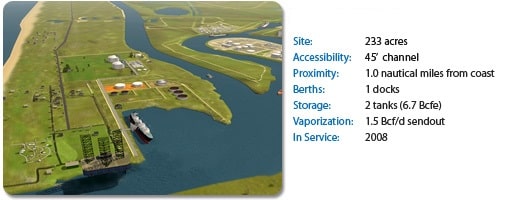FERC has authorized Freeport LNG to liquefy and export liquefied natural gas from its Quintana Island Terminal in Texas.
On July 30, 2014, the Federal Energy Regulatory Commission (FERC) authorized Freeport LNG Development LP to construct and operate facilities for natural gas liquefaction and export from its liquefied natural gas (LNG) import terminal near Freeport, Texas. Freeport LNG is the third LNG export project to receive FERC authorization. It received conditional authorization from the Department of Energy to export LNG to Free Trade Agreement (FTA) and non-FTA countries in May 2013.
The Liquefaction Project includes construction and operation of a liquefaction plant, pretreatment plant facilities, interconnecting pipelines, and facilities to allow bi-directional gas flow through Freeport’s existing pipeline. The liquefaction plant comprises three trains, each capable of producing 4.4 million metric tons of LNG per year, equating to a total capacity of approximately 1.8 Bcf/d of natural gas.

Freeport LNG Terminal (cheniere)
FERC also authorized Freeport LNG’s Phase II Modification Project, which would alter the previously-authorized, not yet constructed Phase II Project, located within Freeport LNG’s existing leased area and adjacent to Phase I facilities on the Quintana Island terminal. Major components of the Phase II Modification Project include reorientation of the Phase II dock and modification of transfer facilities and terminal access roads. The existing Quintana Island Phase I facilities include a marine berthing dock, two containment LNG storage tanks, LNG vaporization systems, and associated facilities. The terminal is connected to the Texas intrastate natural gas pipeline grid by Freeport LNG’s 9.6 mile send-out pipeline.
The authorization adopts FERC staff recommendations, which require Freeport LNG to meet more than 80 conditions to mitigate potential adverse environmental impacts.
Originally published by EnerKnol.
Founded in 2011, EnerKnol provides U.S. energy policy research and data services to support investment decisions across all sectors of the energy industry. Headquartered in New York City, EnerKnol is proud to be a NYC ACRE company.

